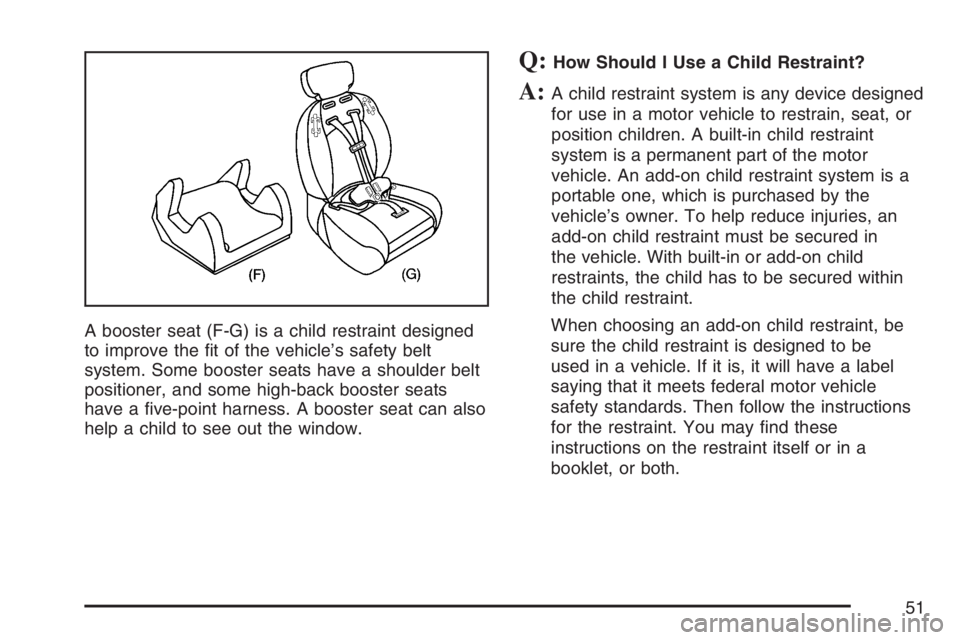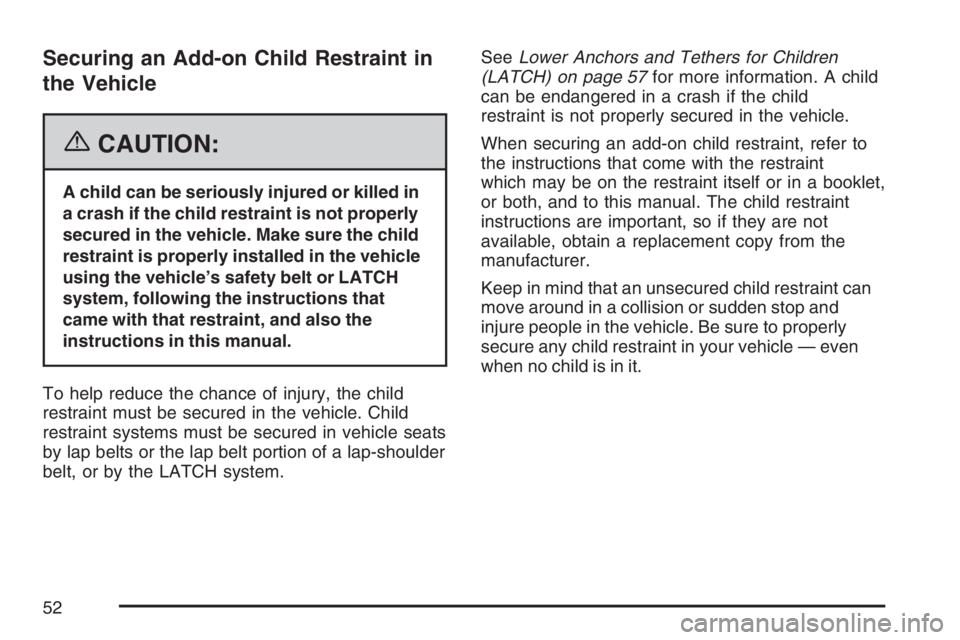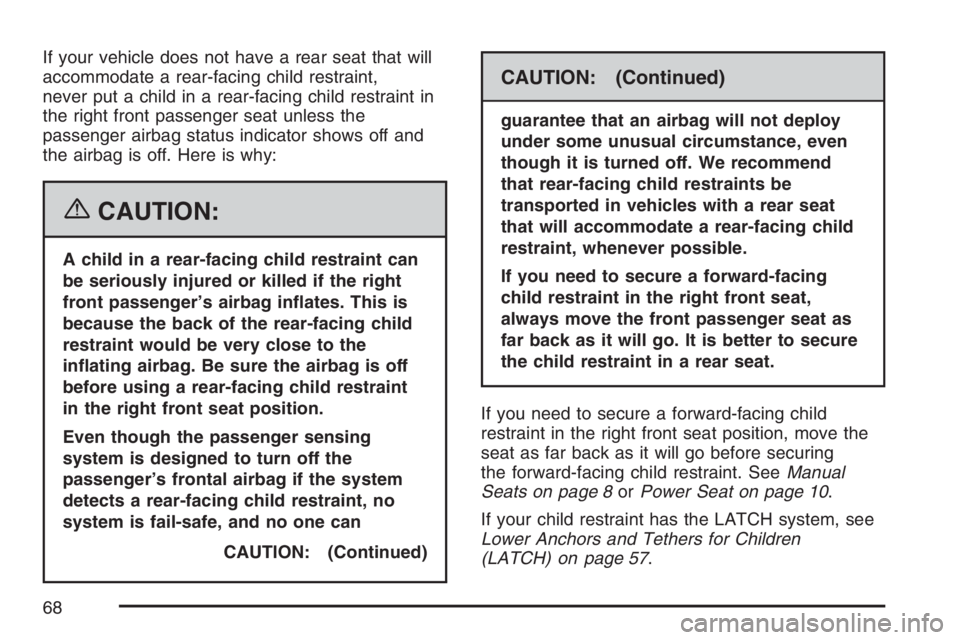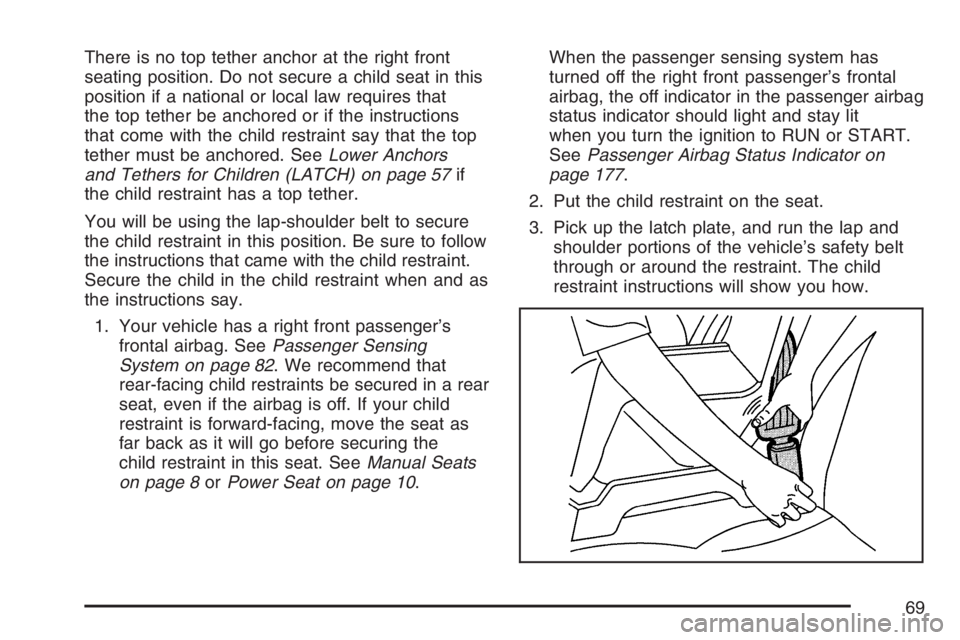Page 25 of 490
How to Wear Safety Belts Properly
This part is only for people of adult size.
Be aware that there are special things to know
about safety belts and children. And there
are different rules for smaller children and babies.
If a child will be riding in your vehicle, see
Older Children on page 43orInfants and Young
Children on page 46. Follow those rules for
everyone’s protection.
First, you will want to know which restraint
systems your vehicle has.
We will start with the driver position.
Driver Position
Lap-Shoulder Belt
The driver has a lap-shoulder belt. Here is how to
wear it properly.
1. Close and lock the door.
2. Adjust the seat so you can sit up straight. To
see how, see “Seats” in the Index.3. Pick up the latch plate and pull the belt across
you. Do not let it get twisted.
The lap-shoulder belt may lock if you pull the
belt across you very quickly. If this happens,
let the belt go back slightly to unlock it.
Then pull the belt across you more slowly.
25
Page 39 of 490
To unlatch the belt, just push the button on the
buckle. For outboard seating positions, when
the safety belt is not in use, slide the latch plate
up the safety belt webbing. The latch plate should
rest on the stitching on the safety belt, near the
guide loop on the side wall.
Rear Safety Belt Comfort Guides
Rear shoulder belt comfort guides may provide
added safety belt comfort for older children
who have outgrown booster seats and for some
adults. When installed on a shoulder belt, the
comfort guide positions the belt away from
the neck and head.
There is one guide available for each outboard
passenger position in the rear seat. Here is how to
install a comfort guide to the safety belt:
1. Remove the guide from its storage clip on the
back of the seatback.
39
Page 42 of 490

Safety Belt Pretensioners
Your vehicle has safety belt pretensioners for the
driver and right front passenger. Although you
cannot see them, they are part of the safety belt
assembly. They help tighten the safety belts during
the early stages of a moderate to severe frontal
or near frontal crash if the threshold conditions for
pretensioner activation are met.
Pretensioners work only once. If they activate in a
crash, you will need to get new ones, and
probably other new parts for your safety belt
system. SeeReplacing Restraint System Parts
After a Crash on page 91.
Safety Belt Extender
If the vehicle’s safety belt will fasten around you,
you should use it.
But if a safety belt is not long enough, your dealer
will order you an extender. When you go in to
order it, take the heaviest coat you will wear, so
the extender will be long enough for you. To
help avoid personal injury, do not let someone else
use it, and use it only for the seat it is made to
�t. The extender has been designed for adults.
Never use it for securing child seats. To wear it,
just attach it to the regular safety belt. For
more information see the instruction sheet that
comes with the extender.
42
Page 43 of 490
Child Restraints
Older Children
Older children who have outgrown booster seats
should wear the vehicle’s safety belts.
Q:What is the proper way to wear safety
belts?
A:An older child should wear a lap-shoulder belt
and get the additional restraint a shoulder belt
can provide. The shoulder belt should not
cross the face or neck. The lap belt should �t
snugly below the hips, just touching the
top of the thighs. It should never be worn over
the abdomen, which could cause severe or
even fatal internal injuries in a crash.
According to accident statistics, children are safer
when properly restrained in the rear seating
positions than in the front seating positions.
In a crash, children who are not buckled up can
strike other people who are buckled up, or can be
thrown out of the vehicle. Older children need
to use safety belts properly.
43
Page 51 of 490

A booster seat (F-G) is a child restraint designed
to improve the �t of the vehicle’s safety belt
system. Some booster seats have a shoulder belt
positioner, and some high-back booster seats
have a �ve-point harness. A booster seat can also
help a child to see out the window.
Q:How Should I Use a Child Restraint?
A:A child restraint system is any device designed
for use in a motor vehicle to restrain, seat, or
position children. A built-in child restraint
system is a permanent part of the motor
vehicle. An add-on child restraint system is a
portable one, which is purchased by the
vehicle’s owner. To help reduce injuries, an
add-on child restraint must be secured in
the vehicle. With built-in or add-on child
restraints, the child has to be secured within
the child restraint.
When choosing an add-on child restraint, be
sure the child restraint is designed to be
used in a vehicle. If it is, it will have a label
saying that it meets federal motor vehicle
safety standards. Then follow the instructions
for the restraint. You may �nd these
instructions on the restraint itself or in a
booklet, or both.
51
Page 52 of 490

Securing an Add-on Child Restraint in
the Vehicle
{CAUTION:
A child can be seriously injured or killed in
a crash if the child restraint is not properly
secured in the vehicle. Make sure the child
restraint is properly installed in the vehicle
using the vehicle’s safety belt or LATCH
system, following the instructions that
came with that restraint, and also the
instructions in this manual.
To help reduce the chance of injury, the child
restraint must be secured in the vehicle. Child
restraint systems must be secured in vehicle seats
by lap belts or the lap belt portion of a lap-shoulder
belt, or by the LATCH system.SeeLower Anchors and Tethers for Children
(LATCH) on page 57for more information. A child
can be endangered in a crash if the child
restraint is not properly secured in the vehicle.
When securing an add-on child restraint, refer to
the instructions that come with the restraint
which may be on the restraint itself or in a booklet,
or both, and to this manual. The child restraint
instructions are important, so if they are not
available, obtain a replacement copy from the
manufacturer.
Keep in mind that an unsecured child restraint can
move around in a collision or sudden stop and
injure people in the vehicle. Be sure to properly
secure any child restraint in your vehicle — even
when no child is in it.
52
Page 68 of 490

If your vehicle does not have a rear seat that will
accommodate a rear-facing child restraint,
never put a child in a rear-facing child restraint in
the right front passenger seat unless the
passenger airbag status indicator shows off and
the airbag is off. Here is why:
{CAUTION:
A child in a rear-facing child restraint can
be seriously injured or killed if the right
front passenger’s airbag in�ates. This is
because the back of the rear-facing child
restraint would be very close to the
in�ating airbag. Be sure the airbag is off
before using a rear-facing child restraint
in the right front seat position.
Even though the passenger sensing
system is designed to turn off the
passenger’s frontal airbag if the system
detects a rear-facing child restraint, no
system is fail-safe, and no one can
CAUTION: (Continued)
CAUTION: (Continued)
guarantee that an airbag will not deploy
under some unusual circumstance, even
though it is turned off. We recommend
that rear-facing child restraints be
transported in vehicles with a rear seat
that will accommodate a rear-facing child
restraint, whenever possible.
If you need to secure a forward-facing
child restraint in the right front seat,
always move the front passenger seat as
far back as it will go. It is better to secure
the child restraint in a rear seat.
If you need to secure a forward-facing child
restraint in the right front seat position, move the
seat as far back as it will go before securing
the forward-facing child restraint. SeeManual
Seats on page 8orPower Seat on page 10.
If your child restraint has the LATCH system, see
Lower Anchors and Tethers for Children
(LATCH) on page 57.
68
Page 69 of 490

There is no top tether anchor at the right front
seating position. Do not secure a child seat in this
position if a national or local law requires that
the top tether be anchored or if the instructions
that come with the child restraint say that the top
tether must be anchored. SeeLower Anchors
and Tethers for Children (LATCH) on page 57if
the child restraint has a top tether.
You will be using the lap-shoulder belt to secure
the child restraint in this position. Be sure to follow
the instructions that came with the child restraint.
Secure the child in the child restraint when and as
the instructions say.
1. Your vehicle has a right front passenger’s
frontal airbag. SeePassenger Sensing
System on page 82. We recommend that
rear-facing child restraints be secured in a rear
seat, even if the airbag is off. If your child
restraint is forward-facing, move the seat as
far back as it will go before securing the
child restraint in this seat. SeeManual Seats
on page 8orPower Seat on page 10.When the passenger sensing system has
turned off the right front passenger’s frontal
airbag, the off indicator in the passenger airbag
status indicator should light and stay lit
when you turn the ignition to RUN or START.
SeePassenger Airbag Status Indicator on
page 177.
2. Put the child restraint on the seat.
3. Pick up the latch plate, and run the lap and
shoulder portions of the vehicle’s safety belt
through or around the restraint. The child
restraint instructions will show you how.
69